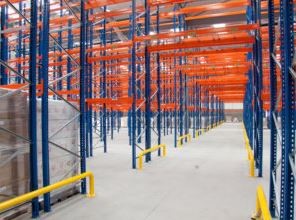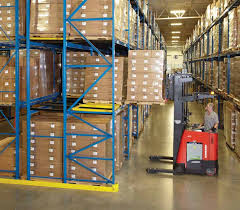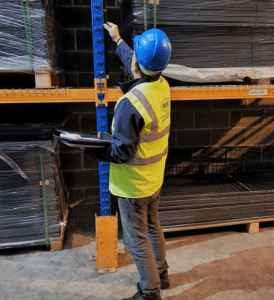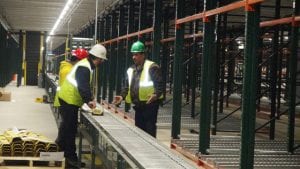Look Within Your Own Walls to Maximize Your Pallet Racking Storage
Managing storage space efficiently is one of the biggest challenges in warehouses and distribution centers in today’s economy. Optimizing your pallet racking storage system is crucial with potential tariffs, increasing demand, and supply chain challenges ahead.
When was the last time you took a step back and looked at your square footage? If you were starting in an empty warehouse, would you do it differently today? Business needs change rapidly, and better space utilization leads to improved productivity and can significantly lower operational costs.
Six essential steps to help maximize your pallet racking storage space
- Understand your inventory data. Math doesn’t lie! Before diving into rack configurations, take a close look at your inventory. The Pareto Principle (80:20 Rule) is still relevant in businesses today. Does 80 % of your sales come from 20% of your SKUs? Does your warehouse reflect that? Categorize items based on size, weight, and, most importantly, turnover rate should be looked at quarterly. Seasonal businesses have an even more calculated situation that can drastically affect your business. This understanding allows you to designate appropriate racking for different products, ensuring faster picking and restocking processes. By grouping fast-moving items, you reduce labor travel time, which enhances overall productivity and saves soft costs.
- Utilize the right racking system. Selecting the appropriate racking system is fundamental. Various options are available, including selective pallet racks, drive-in racks, and flow racks. Each type has its advantages, depending on your inventory. Aisle width matters, and the balance of access and affecting pallet spacing is crucial. Do you need to stage or store? Even with existing racking, narrow aisles
 or very narrow aisles (VNA) can possibly be redesigned in your footprint to add several rows. Even a considerable number of additional pallet positions could be added to your storage capacity. The sizes and widths of your pallets and the right size of your fleet of reach trucks and order pickers are important for the most efficient access. Double-deep racking can significantly increase your storage density for items that don’t need to be as accessible but increase the storage space. Find a material handling partner who provides complete warehouse engineering, design, and planning services. By working with an experienced engineering team who fully understands your application, they can develop multiple design concepts with a complete cost-benefit analysis of each.
or very narrow aisles (VNA) can possibly be redesigned in your footprint to add several rows. Even a considerable number of additional pallet positions could be added to your storage capacity. The sizes and widths of your pallets and the right size of your fleet of reach trucks and order pickers are important for the most efficient access. Double-deep racking can significantly increase your storage density for items that don’t need to be as accessible but increase the storage space. Find a material handling partner who provides complete warehouse engineering, design, and planning services. By working with an experienced engineering team who fully understands your application, they can develop multiple design concepts with a complete cost-benefit analysis of each. - Take your business to new heights and vertical space wisely. When you think you’re out of space, look up. One of the most effective ways to maximize storage is by utilizing available vertical space. Use the cube. As a basic rule, the taller the racking units are, the more pallets you can store. Ensure your warehouse has sufficient ceiling height to allow for this. Based on your town’s building code heights and your company’s future growth projections, there can be a quick ROI with the construction to raise the roof of the warehouse and extend the racking at a minimal property tax increase to the building. Additionally, consider implementing a mezzanine for even greater vertical space efficiency and planning for future growth within the cube.

- Regular maintenance and audits. Maintaining your pallet racking system is vital for safety and efficiency. Regularly inspect your racks for any signs of wear and tear. We have partnered with Damotech, specialists in inspection, rack repair and preventative protection that can strengthen damaged uprights and keep your workers productive and safe. They also can recertify the older rack. Conduct periodic audits to check if the racking setup meets your storage needs as your inventory changes. Address any issues immediately to avoid potential safety hazards.
- Optimize before you automate. Incorporating technology can significantly enhance your space-saving efforts. Automated storage and retrieval systems (AS/RS) automatically transport, store, and sort pallets, containers, and cases onto racks and shelving. This not only uses vertical space effectively but also improves inventory accuracy and labor savings. Kardex vertical lift modules (VLM), with secured and accurate storage within the unit, can retrieve up to 1400 lbs. per tray and a height of up to 98 feet. This saves steps for the picker and increases the pick rate for kitting and parts picking operations. Radioshuttle deep lane storage can optimize the way product is stored and retrieved, making use of otherwise wasted space using a semi-automated pallet shuttle managed by remote control. By implementing a systematic approach, such as the FIFO method or placing the most frequently accessed items at eye level, Radioshuttle will keep your
 operations smooth and efficient. Investing in robotics or conveyor systems can further streamline your warehouse operations for the correct application. We can also engineer and offer fully automated solutions tailored to your needs.
operations smooth and efficient. Investing in robotics or conveyor systems can further streamline your warehouse operations for the correct application. We can also engineer and offer fully automated solutions tailored to your needs. - The path to operational excellence starts with you. Suppose you’re unsure how to maximize your business and don’t know where to start. In that case, a Raymond Lean Management (RLM) complete business analysis can kickstart your path to continuous improvement and examine your organizational goals today, tomorrow, and beyond.
Ready to discover potential storage space?
Need an immediate evaluation? Let us provide you with 100+ years’ worth of experience with Abel Womack, the “Best of Breed” in material handling solutions. You are invited to discover the difference and visit our website at www.abelwomack.com. We’re here to help you maximize your storage space and improve your warehouse operations.






Leave a Reply
You must be logged in to post a comment.